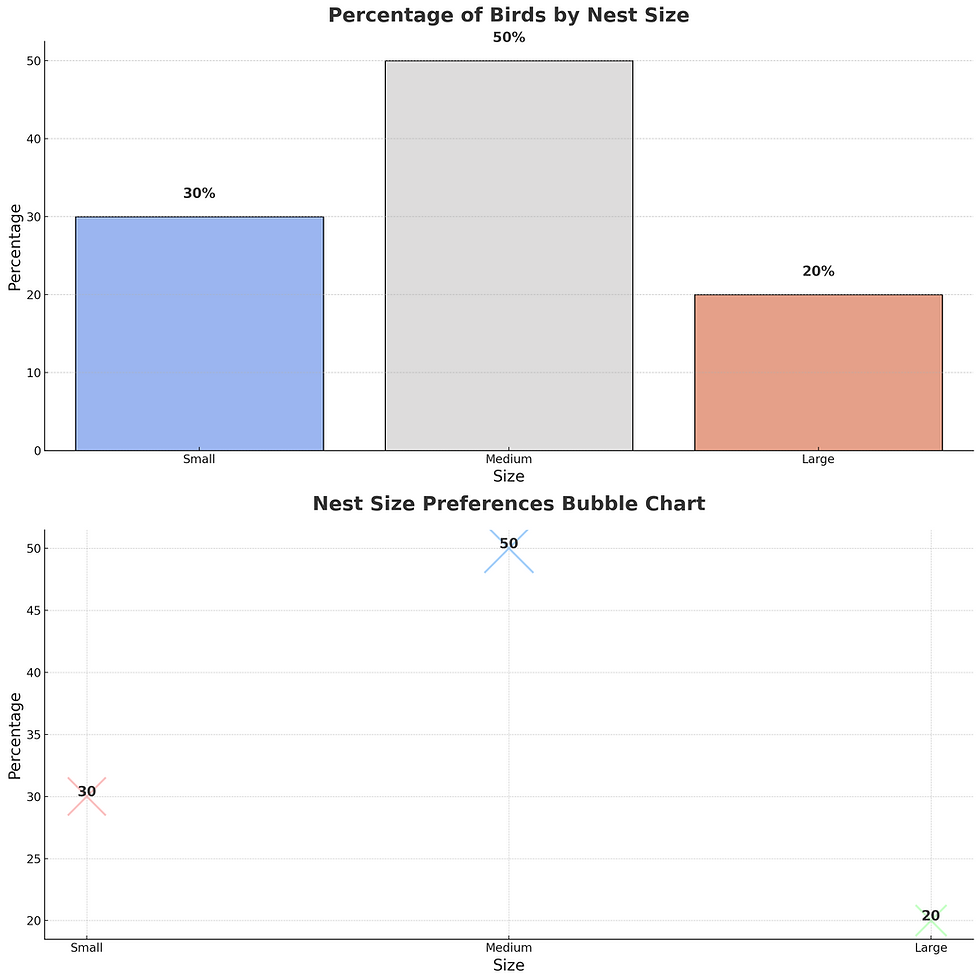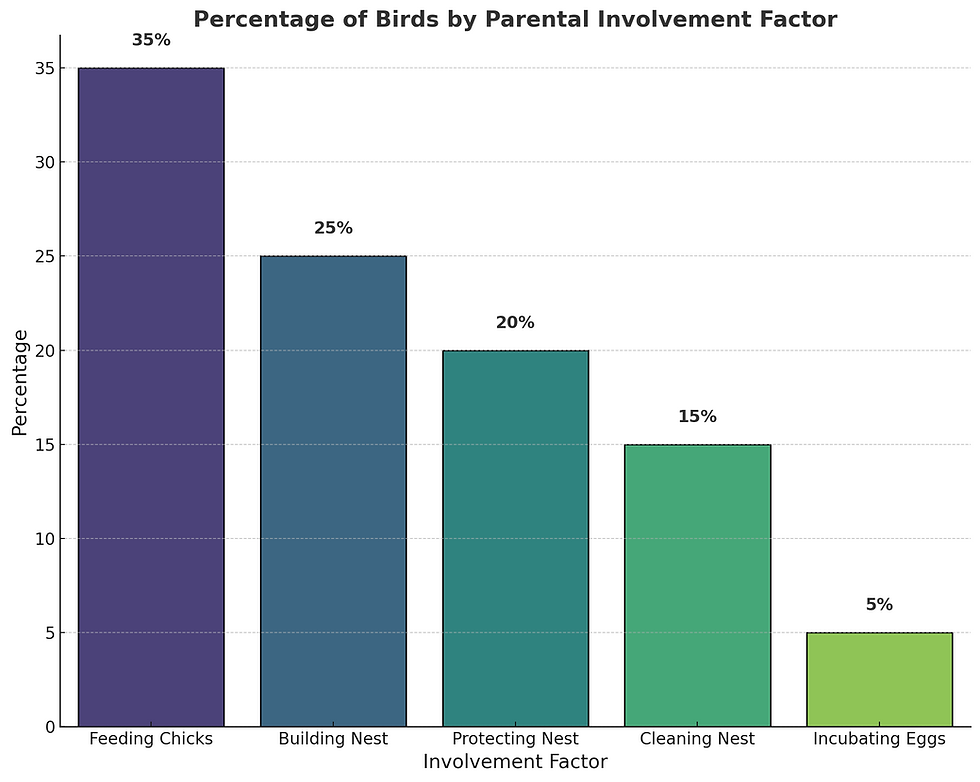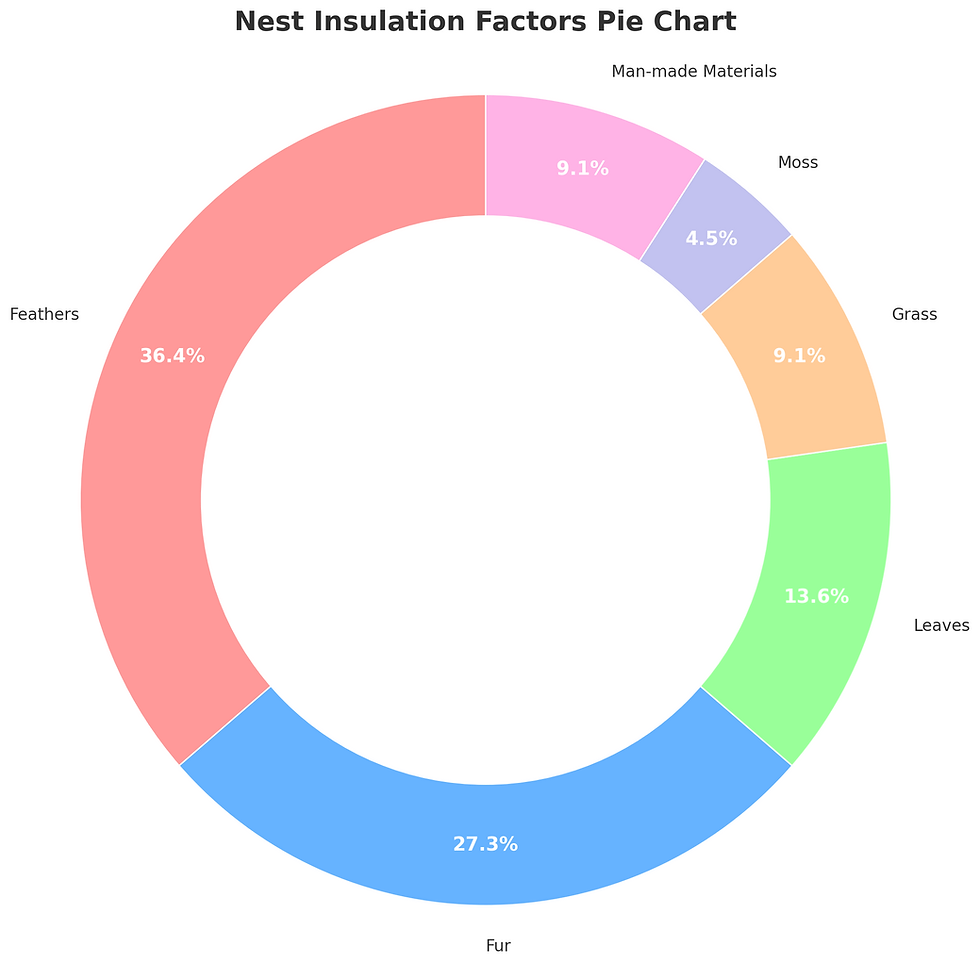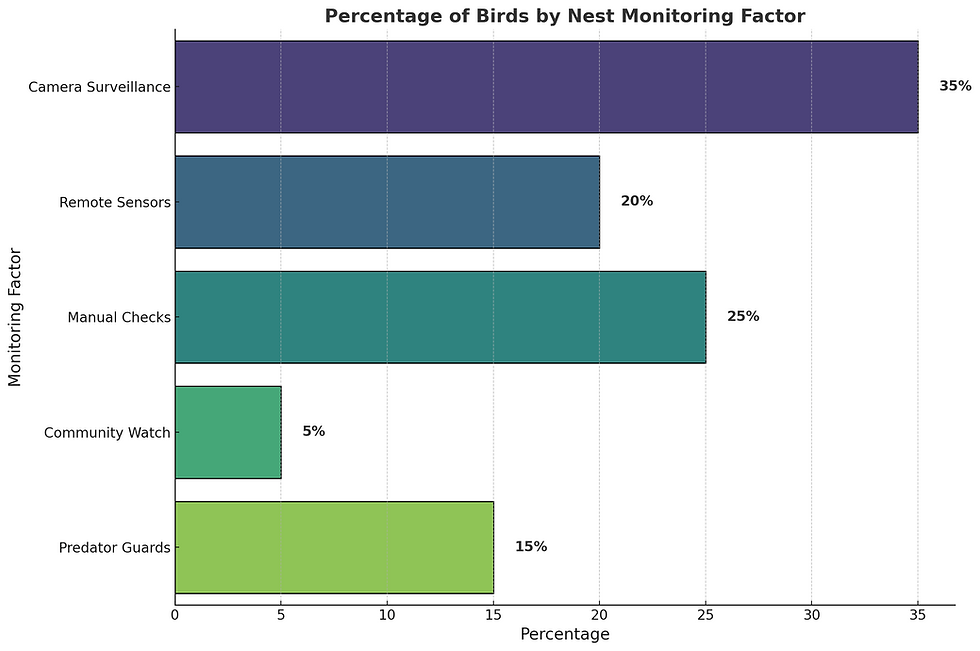Nesting Requirements for Breeding Birds
- Saifur Rahman
- Aug 4, 2024
- 10 min read

Key Takeaways
Key Points | Descriptions | Implications |
Importance of Nest Location | Birds choose nest locations based on safety, food availability, and environmental factors. | Understanding nest location preferences can help in conservation and habitat protection. |
Variety of Nest Materials | Birds use various materials like twigs, leaves, and mud to build nests. | Knowing preferred materials can aid in providing suitable nesting environments. |
Impact of Nest Size | The size of a nest affects the survival rate of chicks and varies by species. | Helping birds build appropriately sized nests can increase breeding success. |
Diversity in Nest Shape | Birds construct nests in different shapes for stability and safety. | Recognizing different nest shapes can assist in identifying bird species and their needs. |
Security Measures | Birds implement various strategies to protect their nests from predators. | Enhancing nest security measures can improve breeding outcomes. |
Climate Control Mechanisms | Birds regulate nest temperature and protect from weather conditions. | Providing materials and locations that aid climate control can boost nest viability. |
Introduction
Nesting is very important for birds. Did you know that 80% of bird species rely on well-built nests for their chicks to survive? This shows how crucial nesting requirements are for breeding birds.
Nests are more than just homes. They protect eggs and chicks from the weather and predators. Birds use many skills to build their nests, choosing the best materials and locations.
Why Nests Matter | Key Points |
Protection | Safe from predators and weather |
Warmth | Insulated to keep chicks warm |
Survival | Higher chances of chick survival |
Understanding how birds build and use their nests helps us protect them. By learning about nest location, materials, size, shape, security, and hygiene, we can support bird conservation.
Each bird species has unique nesting requirements. This article explores these needs to help you learn how to create safe environments for birds. You can make a big difference in their lives!
01. Nest Location

Where do birds prefer to build their nests?
Birds prefer to build their nests in safe places. Trees, ground, and bushes are common choices. The right location helps keep the nests and chicks safe.
What factors influence a bird's choice of nest location?
Birds look for safety and food when picking a nest spot. They choose places where predators can't reach easily and where food is nearby.
How does the nest location vary among different bird species?
Different birds like different spots. Forest birds may prefer trees, while urban birds might use buildings. Each bird finds what suits them best.
What are the pros and cons of different nest locations?
Each spot has its good and bad points. Ground nests are easy to build but may face more predators. Tree nests are safer but harder to build.
How do environmental changes affect nest location choices?
Changes in the environment, like deforestation or climate change, make birds choose new spots. They adapt to find the best places to build nests.
What role does human activity play in altering nest locations?
Humans change where birds build nests. Urbanization and deforestation push birds to find new spots. You can learn more about this in introducing new birds.
02. Nest Material

What types of materials do birds commonly use to build nests?
Birds use twigs, leaves, and mud to build nests. These materials are easy to find and strong enough to hold the nest together.
How do different bird species select nest materials?
Birds pick materials based on what’s around them. They choose things that are strong and can make a good nest. Some even use feathers and fur.
What are the advantages of using specific materials?
Using the right materials keeps the nest safe and warm. Feathers and soft plants provide insulation, while twigs and mud add strength.
How do birds gather and transport nest materials?
Birds use their beaks and claws to gather materials. They carry them back to the nest site, sometimes making many trips.
How does the quality of nest materials impact the success of breeding?
Good materials make strong nests. This helps keep the eggs and chicks safe, leading to more successful breeding.
Are there any synthetic materials that birds use for nesting?
Sometimes birds use synthetic materials like plastic or paper. While these can be useful, they aren’t always the best for the birds. Learn more about DIY bird toys.
03. Nest Size

How does the size of a nest vary among bird species?
The size of a nest can be different for each bird species. Small birds need small nests, while big birds need big nests.
What factors determine the size of a bird's nest?
Birds decide nest size by how many eggs they lay and how big the chicks will be. More eggs mean a bigger nest.
How does nest size affect the survival rate of chicks?
Big nests give chicks more room to grow. They also help keep chicks warm. This helps chicks survive.
What are the challenges in constructing larger nests?
Finding enough materials
Keeping the nest strong
Protecting it from wind and rain
How do birds maintain and expand their nests over time?
Birds add more materials to their nests as chicks grow. They repair any damage to keep the nest safe.
What is the relationship between nest size and the bird's habitat?
Birds in big open spaces can build bigger nests. Birds in small areas need smaller nests. You can learn more about cage size guidelines.
04. Nest Shape

What are the different shapes of bird nests?
Bird nests come in many shapes. Some are cup-shaped, some are like platforms, and some are round like balls.
How does nest shape affect the stability and safety of the nest?
The shape of a nest helps keep it strong. Round nests can handle wind better. Flat nests are good for big birds.
How do birds determine the shape of their nests?
Birds know how to build their nests by instinct. Each species has its way of building the perfect nest shape.
What are the functional advantages of different nest shapes?
Different shapes have different uses:
Cup-shaped nests keep eggs safe
Flat nests give more space for chicks
Round nests stay warm and strong
How do environmental factors influence nest shape?
The environment changes how nests are built. Windy places need strong shapes. Rainy areas need nests that drain water well.
How do birds construct nests with complex shapes?
Birds use special skills to make complex shapes. They weave materials together and use mud to hold things in place. Learn more about DIY bird toys.
05. Nest Security

What measures do birds take to secure their nests from predators?
Birds use many tricks to keep their nests safe. They hide nests in high places, use camouflaged materials, and choose spots that are hard for predators to reach.
How effective are these security measures in protecting the nest?
These tricks work well. Hidden nests are hard for predators to find, and high nests are safe from ground animals. Learn more about breeding pairs.
How do birds respond to threats near their nests?
Birds get very protective. They may attack or chase away predators. They also make loud noises to scare threats.
What are the common predators of bird nests?
Many animals want to eat bird eggs. Common predators are snakes, squirrels, and bigger birds.
How does nest location contribute to nest security?
Nest location is very important. High trees and dense bushes make nests hard to find. Birds pick the best spots to keep their eggs safe.
What role does camouflage play in nest security?
Camouflage is a great way to protect nests. Birds use materials that blend in with the surroundings. This makes it hard for predators to spot the nest.
06. Nest Climate Control

How do birds regulate the temperature in their nests?
Birds use many methods to keep nests comfy. They pick spots with the right sunlight and wind. They also use materials that keep heat in or out.
What materials are best for insulating nests?
Feathers and soft plants are great for insulation. They keep the nest warm when it’s cold and cool when it’s hot.
How do birds protect their nests from extreme weather conditions?
Birds build strong nests to withstand weather. They choose sheltered spots and use sturdy materials. Some nests even have roofs!
How does nest construction vary in different climates?
In hot places, nests are built to stay cool. In cold places, nests are made to keep warm. Birds know just what to do for their climate.
What are the signs of poor climate control in bird nests?
If chicks are too hot or cold, the nest might have bad climate control. This can lead to sick or weak chicks.
How do birds ventilate their nests?
Birds build nests with good airflow. This keeps the nest fresh and comfy. They make sure there are small gaps for air to move through. Learn more about cleaning the cage.
07. Nest Hygiene

How do birds keep their nests clean?
Birds work hard to keep their nests clean. They remove waste and bring in fresh materials. Clean nests keep chicks healthy and happy.
What are the common parasites that infest bird nests?
Parasites like mites, lice, and fleas can infest nests. Birds must keep their nests clean to protect their chicks from these pests.
How does nest hygiene affect the health of chicks?
Good hygiene keeps chicks healthy. Clean nests prevent diseases and help chicks grow strong.
What are the behaviors associated with maintaining nest hygiene?
Removing waste
Bringing in clean materials
Frequent cleaning
How do birds remove waste from their nests?
Birds carry waste away from the nest. Some birds even eat the waste to keep the nest clean. Learn more about cleaning the cage.
How does poor hygiene impact nest success?
Poor hygiene can make chicks sick. Dirty nests attract parasites and disease, leading to higher chick mortality.
08. Parental Involvement

How do bird parents share responsibilities in nest building?
Both parents help build the nest. They gather materials together and work as a team to make a strong home.
What roles do male and female birds play in nest maintenance?
Both male and female birds share in maintaining the nest. They clean, repair, and protect it together.
How does parental involvement vary among species?
Different birds have different roles. In some species, both parents are very involved. In others, one parent takes the lead.
What are the benefits of high parental involvement in nesting?
High parental involvement leads to healthy chicks. Both parents working together ensures the nest is safe and clean.
How do parents ensure the safety of their eggs and chicks?
Parents stay close to the nest. They defend it from predators and make sure the chicks are safe. Learn more about introducing new birds.
How do birds train their chicks to leave the nest?
Parents teach their chicks to fly and find food. They encourage the chicks to explore and leave the nest when ready.
09. Nest Accessibility

How do birds design their nests for easy access?
Birds make sure their nests are easy to get to. They build them with openings that are just the right size for them to enter and exit quickly.
What are the challenges birds face in accessing their nests?
Birds sometimes face problems like predators and bad weather. These can make it hard to reach their nests safely.
How does nest accessibility affect feeding and care of chicks?
Easy access means parents can feed and care for their chicks more often. This helps chicks grow strong and healthy.
How do predators exploit nest accessibility?
Predators look for nests that are easy to reach. Birds must balance making nests accessible for themselves but not for predators.
What adaptations do birds make to improve nest accessibility?
Birds use clever tricks like hiding nests in hard-to-reach places. They also build nests in places where only they can enter. Learn more about choosing a cage.
How does nest height impact accessibility?
Nests high in trees are harder for predators to reach. However, they can also be harder for birds to access during bad weather.
10. Nest Insulation

What materials provide the best insulation for bird nests?
Feathers, fur, and soft plants are great for insulation. They help keep the nest warm in the cold and cool in the heat.
How do birds layer materials for effective insulation?
Birds layer materials like a sandwich. They put soft, warm stuff inside and strong materials outside to protect it all.
How important is insulation for chick survival?
Good insulation is very important. It keeps chicks at the right temperature, helping them stay healthy and grow well.
How does nest insulation vary across climates?
Birds in cold places need more insulation. In hot places, they use materials that keep the nest cool.
What are the signs of poor insulation in nests?
Cold or sick chicks are a sign of poor insulation. A nest that feels damp or drafty might also have bad insulation.
How do birds repair and maintain nest insulation?
Birds keep adding new materials to their nests. They replace old, worn-out stuff with fresh, warm materials. Learn more about daily care routine.
11. Nest Camouflage

How do birds use natural elements to camouflage their nests?
Birds use natural elements like leaves, branches, and moss to hide their nests. This helps keep their eggs and chicks safe from predators.
What are the benefits of effective nest camouflage?
Good camouflage makes nests hard to see. This protects them from predators and keeps chicks safe.
How do birds choose locations that enhance camouflage?
Birds pick spots that match their nest materials. They look for places where their nests blend in with the surroundings.
What are the common camouflage strategies used by different species?
Using materials that match the environment
Building nests in hidden spots
Covering nests with leaves or bark
How does the surrounding environment aid in nest camouflage?
The environment helps hide the nest. Dense bushes, tall trees, and thick foliage all make nests harder to spot.
What are the challenges of camouflaging nests in urban areas?
Urban areas have fewer natural materials. Birds must get creative, using things like paper and plastic to blend in. Learn more about breeding basics.
12. Nest Monitoring

How do birds monitor their nests for safety?
Birds keep a close watch on their nests. They stay nearby and check on their eggs and chicks often.
What behaviors indicate active nest monitoring by birds?
Birds show they are watching their nests by staying close. They may fly around the nest and look out for danger.
How do birds respond to disturbances at their nests?
Birds get very protective. They may attack or make loud noises to scare away threats.
What are the technologies used by researchers to monitor bird nests?
Researchers use cameras and sensors to watch nests. These tools help study bird behavior without disturbing the nests.
How does nest monitoring impact breeding success?
Monitoring helps keep nests safe. Parents can quickly respond to dangers and ensure their chicks are protected.
What are the signs that a nest is being closely monitored by its occupants?
Signs include frequent visits by the parents and alert behaviors. Birds will often stay close and watch their nests carefully. Learn more about basic commands.
Conclusion
Birds need nests to keep their eggs and chicks safe. Each part of the nesting requirements is important. From the right location to the best materials, every detail helps chicks survive and grow.
We learned that nests protect birds from weather and predators. They keep chicks warm and give them a safe place to grow. Understanding these needs helps us support bird conservation.
Key Points | Benefits |
Safe Location | Protects from predators |
Good Materials | Keeps the nest strong and warm |
Proper Size | Provides enough space for chicks |
By helping birds with their nesting requirements, we can ensure they have a better chance to thrive. Small actions like providing nesting materials or protecting nesting sites can make a big difference.
Let's work together to support our feathered friends. We can create a safer world for them to raise their families and continue to fill our skies with their beautiful songs.


Comments